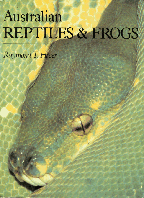 CLASS AMPHIBIA
CLASS AMPHIBIA
ORDER SALIENATA (FROGS AND TOADS).
FAMILY BUFONIDAE (TOADS)
These 'true toads' do not occur naturally in Australia, although they are abundant in most other parts of the world. Toads are characterized by a warty dry skin, and usually highly visible poison glands on the back of the head and elsewhere. Reproductive modes and life cycles of different species of toad vary considerably.
The Cane Toad Bufo marinus was introduced into north east Australia in 1935.
CANE OR MARINE TOAD Bufo marinus (Linnaeus, 1758)
The only 'true Toad' found in Australia, it was introduced here around 1935 from Hawaii and South America. It was introduced to control the pest Sugar Cane Beetle (Dermolepida albohirtum).
The toad itself became a major pest and it's distribution grows annually. Currently found all over Queensland and adjacent areas, it will no doubt eventually be found Australia wide unless immediate steps are taken to stop the species expansion.
Cane Toads are large and ugly in appearance, up to 20cm in length, with large highly visible poison glands located at the back of the head, (The paratoid glands).
The toads are a major pest for several reasons. Their tadpoles eat other frogs tadpoles, and because the toads will breed in all available fresh or brackish water bodies, other species of frog die out when Toads become established in their native areas.
The toads also lay thousands of eggs at a time thereby allowing their range to increase at an alarming rate. A single female is capable of laying some 35 000 eggs per year. Most animals that are small enough to fit into the mouth of a Toad will be eaten.
Species that may eat the toads will be poisoned. Therefore the Toads wipe out all frogs, frog eating reptiles and birds, and most other vertebrate wildlife, either directly or indirectly when they move into an area.
Although found in most habitats Cane Toads are usually found near human habitation. The call of the Cane Toad is an unmistakable mechanical sounding 'pop-pop-pop'.
The above was from the book Australian Reptiles and Frogs by Raymond Hoser and now available on a fantastic CD-Rom along with a vast amount of other information, papers and the like on reptiles, frogs and other wildlife.